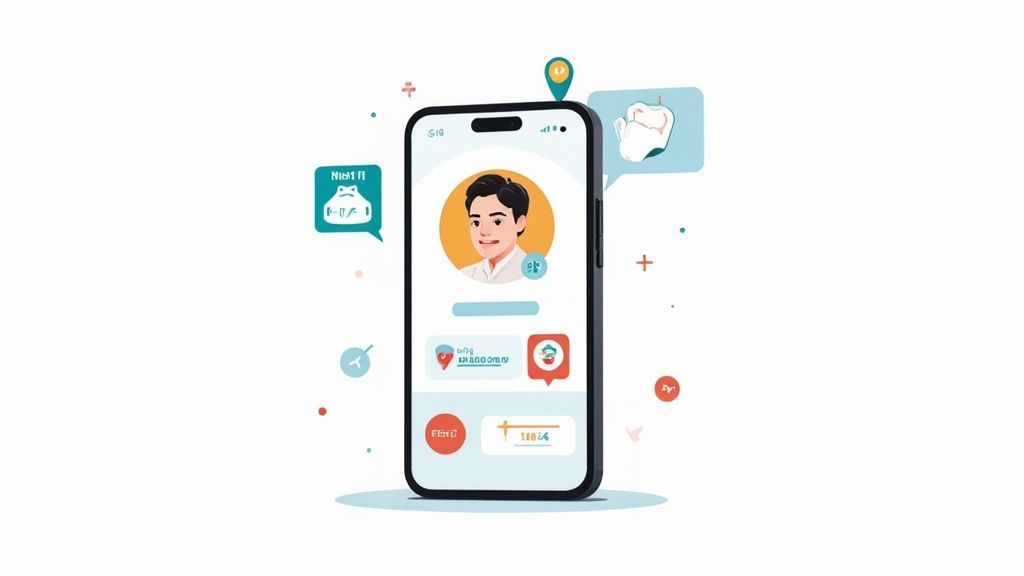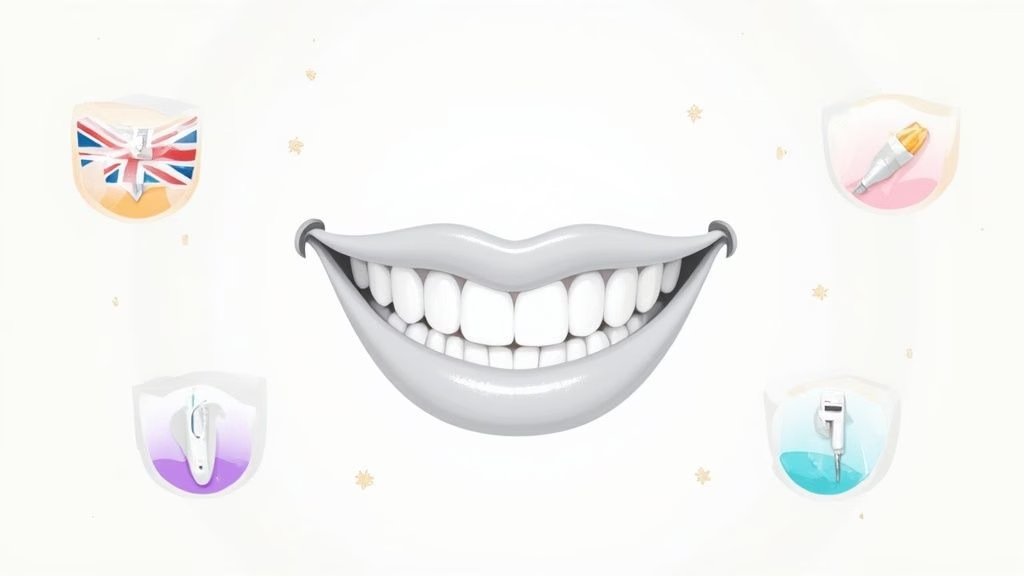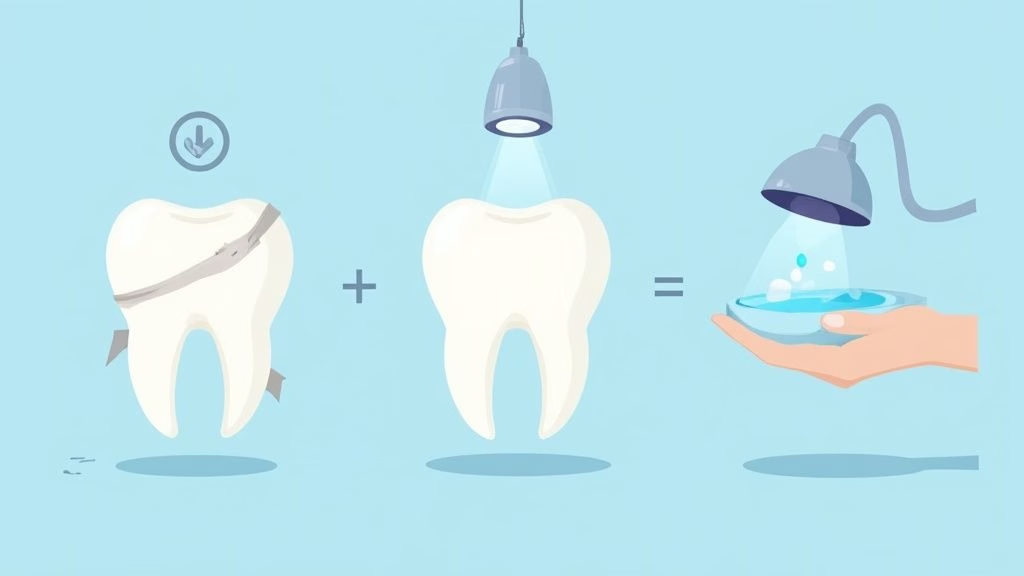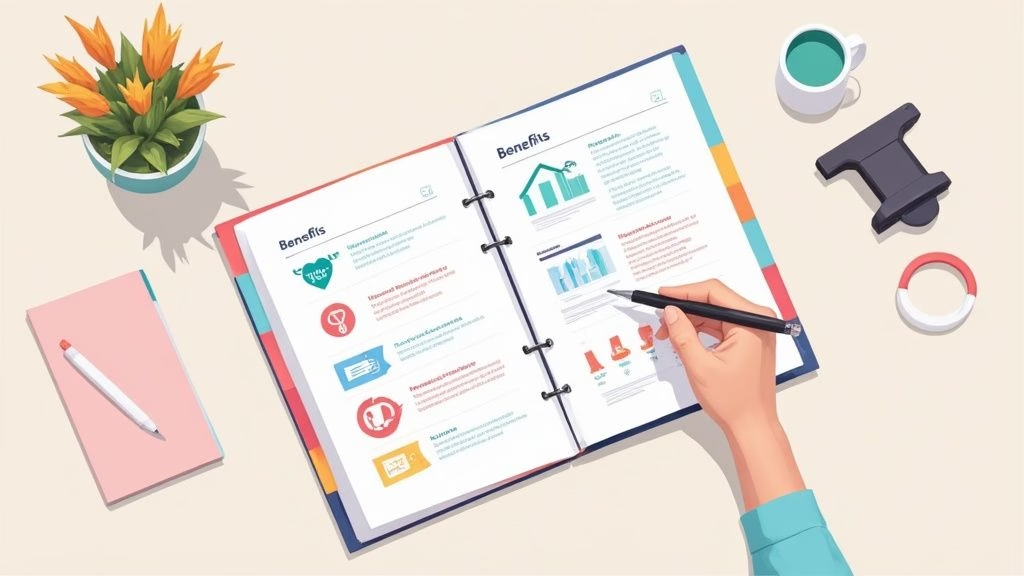Need an Emergency Dentist Open Now? Your UK Action Plan

When a dental emergency hits, your first thought is usually a mix of panic and pain. The most important thing is to take control of the situation and find an emergency dentist open now. What you do in that first hour can genuinely be the difference between saving or losing a tooth, not to mention getting on top of the pain before it gets worse.
What to Do Right Now in a Dental Emergency
It’s completely natural to feel panicked when you’re dealing with a sudden injury or agonising toothache, but a few calm, measured steps can help stabilise the problem. Your immediate goals are simple: manage the pain, stop any further damage, and hold onto any bits of tooth that have come loose. Think of it as dental first aid.
The right first step really depends on what kind of emergency you're facing. This quick visual guide breaks down the most common dental injuries and what to do for each.

As you can see, your initial response is crucial. Whether it's carefully preserving a knocked-out tooth or protecting the area around a lost filling, getting it right sets you up for a much better outcome when you see the dentist.
Dealing With Common Dental Injuries
A knocked-out tooth is probably the most urgent dental emergency there is. If it happens, you need to act fast. Gently rinse the tooth with a bit of milk or even your own saliva, but be very careful not to touch the root. If you can, try to place it back into the socket. If that feels impossible, pop it in a small container of milk to keep the root alive. Time is absolutely critical here.
For a chipped tooth or a lost filling, the priority changes. Now, it's about protecting your mouth from any sharp edges and keeping the sensitive, exposed area clean. You can temporarily cover a sharp bit of tooth with some sugar-free chewing gum or a piece of dental wax. Rinsing your mouth with salt water (about half a teaspoon of salt in a glass of warm water) is also a great way to clean the area and soothe any inflammation.
To help you react quickly, here’s a simple table summarising what to do.
Dental Emergency First Aid
Use this quick guide to identify your dental emergency and take the right first steps for pain relief and tooth preservation.
| Emergency Type | Immediate Action | Pain Management Tip |
|---|---|---|
| Knocked-Out Tooth | Gently rinse the tooth (don't touch the root), try to reinsert it, or store it in milk. See a dentist within the hour. | Apply a cold compress to the outside of your cheek to reduce swelling. Avoid putting anything directly on the socket. |
| Chipped/Broken Tooth | Rinse your mouth with warm water. If there's bleeding, apply gauze. Cover sharp edges with dental wax or sugar-free gum. | Over-the-counter painkillers like paracetamol can help. A cold compress will also numb the area. |
| Lost Filling or Crown | Keep the area clean. If you still have the crown, you can try temporarily re-seating it with dental cement from a chemist. | Clove oil applied with a cotton bud can provide temporary, localised relief to the exposed tooth. |
| Severe Toothache | Rinse with warm salt water and gently floss to remove any trapped food. Do not apply aspirin directly to the tooth or gums. | Take ibuprofen or paracetamol as directed. Avoid very hot or cold foods that might trigger more pain. |
| Dental Abscess | Rinse your mouth several times a day with a mild salt-water solution to draw pus to the surface. This is serious—seek help. | A cold compress can ease discomfort, but this requires immediate professional attention to treat the infection. |
Remember, these are just temporary measures to get you through until you can see a professional.
Safe Pain Relief at Home
Getting the pain under control is key while you're arranging to see a dentist. Standard over-the-counter painkillers available in the UK, like paracetamol or ibuprofen, can be very effective. Just be sure to follow the dosage instructions on the packet and double-check they're safe for you to take with any other medications or health conditions you might have.
A cold compress is your best friend for swelling and pain. Just wrap some ice or a bag of frozen peas in a tea towel and hold it against your cheek for 15-20 minutes at a time. Whatever you do, don't apply heat—it will only make the inflammation and pain worse.
Taking these initial steps puts you back in control of a stressful situation. By managing the immediate injury and getting a handle on the pain, you buy yourself precious time to find the right professional help without things getting any worse.
How to Find an Emergency Dentist Open Now
When you're in agony, the last thing you need is a frustrating search for care. Finding an emergency dentist open now is all about having a clear, calm strategy. Your goal is to get in front of a professional as quickly as you can, and thankfully, you've got a few solid options here in the UK.

For many, the first port of call is NHS 111. This service is specifically designed to point you towards the right urgent care when your regular dentist is shut. It’s an essential resource, but let's be honest—waiting for a callback can feel like an eternity when every throb of pain is unbearable.
Navigating the NHS 111 Service
When you ring NHS 111, a trained advisor will run through a series of questions to figure out what's going on. To make that call as smooth as possible, it really helps to have some key information at your fingertips.
Before you dial, try to have this ready:
- Your symptoms: Be really specific. Where is the pain? Is it sharp, throbbing, or a dull ache? When did it start?
- The cause: If there was an accident, explain what happened. Is a tooth loose, chipped, or completely knocked out?
- Personal details: They'll need your name, address, date of birth, and your NHS number if you have it handy.
- Your health background: Let them know about any existing conditions or medications you’re currently taking.
With this information, the advisor can point you in the right direction. They might book you an appointment at an out-of-hours dental service, give you some self-care advice, or tell you to head to A&E if it sounds serious.
The Modern, Faster Alternative
But waiting for that callback isn't always an option. Modern technology has stepped in with a much more immediate solution. Services like Toothfairy offer a smarter, more direct route to a qualified dentist, letting you skip the initial phone triage and long waiting times.
With Toothfairy, you can jump on a secure video consultation with a UK-based dentist 24/7, often within just a few minutes. This instant connection means you get professional advice, an assessment, and even a prescription sent straight to your local pharmacy without leaving your sofa.
This completely changes the game for finding emergency care. Instead of trying to describe your symptoms over the phone, a dentist can actually see the problem, leading to a much more accurate diagnosis and a faster plan of action. The systems that enable this seamless connection between patients and care are fascinating; you can learn more about these comprehensive patient access solutions.
This digital-first approach is a lifesaver for getting swift pain relief or antibiotics for a nasty infection, which are often the most pressing needs. It's a modern, affordable, and incredibly convenient alternative to the traditional, and often slower, route. By picking the right path for your situation, you can get the help you need without any of the extra stress.
Knowing When to Head Straight to A&E
Most of the time, a dental crisis means finding an emergency dentist. But some situations are genuinely beyond what a dentist's office can handle and need immediate hospital care. It’s crucial to know the difference, because getting to A&E when you really need to can prevent serious, even life-threatening, complications.

We're not talking about a standard toothache or a chipped veneer here. A trip to the hospital is for when a dental problem becomes a wider, more dangerous medical issue. Learning to spot these red flags means you'll get the right care, right away.
The Red Flags: When It’s Time for the Hospital
Think of it like this: a dentist fixes problems inside your mouth. A&E deals with anything that threatens your overall health. If your dental issue comes with any of the following symptoms, your safest bet is a trip to the hospital.
Here are the critical warning signs that mean you need A&E, not a dentist:
- Bleeding That Won't Stop: If you've been applying firm pressure to a wound in your mouth for 15-20 minutes and the bleeding is still heavy, that's a medical emergency.
- Rapid and Severe Facial Swelling: Swelling that is visibly getting worse, especially if it starts to interfere with your vision, breathing, or swallowing. This can be a sign of a dangerous infection spreading through your body.
- Serious Facial Injury: A significant blow to your face or jaw from a fall, a car accident, or any other impact requires an urgent medical evaluation. You could have a fracture or other internal injuries a dentist simply isn't equipped to diagnose or treat.
- High Fever Alongside Mouth Pain: A high temperature combined with a toothache or an abscess can signal a systemic infection that needs immediate medical treatment.
Let's put it into a real-world context. A small, painful swelling on your jaw is definitely a job for an emergency dentist. But if that swelling starts to spread down your neck and you find it hard to catch your breath, that’s your cue to call 999 or get to A&E immediately.
It's important to remember that A&E doctors are not dentists. Their job is to manage the immediate medical danger—they'll stop the bleeding or get you on an IV of strong antibiotics for a severe infection. They won't, however, perform a root canal or extract a tooth. They’ll stabilise you.
Once the immediate crisis is over, you'll still need to see a dentist to fix the underlying dental problem. This is where a virtual consultation, like those offered by Toothfairy, can be a lifesaver. After being discharged, you can have a dentist assess the situation and plan your next steps without having to travel anywhere else.
Why Is It So Hard to Find a Dentist in the UK?
If you’ve ever tried to find an NHS dentist, especially in a hurry, you’ll know how frustrating it can be. Let me be clear: you’re not imagining it. There's a real, deep-rooted problem with dental access across the country. So when you’re desperately searching for an emergency dentist open now and keep hitting dead ends, it’s not you – it’s the system.

Millions of people are in the same boat, and knowing a bit about the 'why' can help make sense of the situation. It also shines a light on why new ways of getting care are becoming so crucial.
The Reality of 'Dental Deserts'
You might have heard the term ‘dental desert’. It perfectly describes areas of the UK with virtually no NHS dental services available. In these places, practices have shut their books to new patients, or their waiting lists are so long that even a routine check-up is months, if not years, away. An emergency appointment? It’s practically a fantasy.
This creates a postcode lottery for something as fundamental as oral health. It leaves people with impossible choices: either give up entirely, or stretch their finances for private treatment. When a sudden, painful emergency strikes, this lack of access means people are left to suffer, often for far too long.
A Patchwork of Dental Care Across the Nation
The problem isn't the same everywhere. Access to a dentist can change dramatically from one town to the next, creating a real patchwork of care across the UK. Think it’s a level playing field? Think again.
The 2025 GP Patient Survey data tells a revealing story. While on the surface it looks like 78% of people who tried to get an NHS appointment succeeded, that number masks huge regional gaps. In the South West, for example, the success rate plummets to well below two-thirds. You can dive into the specifics and see just how varied the picture is by checking out the challenges in NHS dental access on the official NHS England website.
What this data really confirms is a simple truth many of us have experienced firsthand: your chances of getting timely dental care heavily depend on your address. The traditional system is creaking under the strain and simply wasn’t built for the kind of on-demand care people need today.
The struggle to find an available dentist, especially out of hours, isn’t just an inconvenience—it’s a critical gap in our healthcare system. It leaves people in pain and without a clear path to relief, forcing them to wait or seek more drastic solutions.
This is exactly the gap that modern solutions are designed to fill. Toothfairy is the smarter, more affordable way to access dental care, cutting through the geographical red tape and scheduling nightmares. By offering 24/7 access to qualified dentists through a video call, we provide a smart, affordable way to get a professional assessment, advice, and even a prescription, no matter where you are or what time of day it is. It's about getting you the essential care you need, right when the old system can't.
How to Prepare for Your Emergency Appointment
So, you’ve managed to book an emergency slot. That’s a huge relief. Taking just a few minutes now to get organised can make your appointment—whether it's face-to-face or online—go so much more smoothly.
When you're in pain, it's easy to feel flustered. But having the right details to hand means the dental team can quickly and safely figure out what's wrong and how to help.
Getting Your Details in Order
Before you head out or log on, try to gather a few key bits of information. Don't stress if you can't find everything, but whatever you can pull together will be a big help.
Here’s a quick checklist of what your dentist will likely ask for:
- Current medications: This isn't just about prescriptions. Make a note of any over-the-counter painkillers, vitamins, or supplements you take regularly.
- Your medical history: Think about major health conditions like diabetes or heart issues. Crucially, mention any allergies, especially to things like penicillin or local anaesthetics.
- The story of the emergency: Be ready to explain what happened. When did the pain kick in? Was it a sudden injury or something that's been building up? What does it feel like now?
This background information is vital. Modern dental practices often rely on technology like advanced dental imaging with CBCT scans for a precise diagnosis, and your medical history provides the context they need to interpret those images correctly.
Nailing a Virtual Consultation
If you're using a service like a Toothfairy video call, a little bit of prep work goes a long way.
First, find a quiet spot with good lighting. The torch on your phone is your best friend here—it can really help the dentist get a clear look inside your mouth at the problem area.
Here's a pro tip: do a quick practice run before the call. Use your phone's selfie camera to see how you can best show the dentist the tooth or gum that's bothering you. Getting comfortable with this beforehand makes the actual examination much faster and more effective.
Getting this stuff sorted means you can focus on what matters: getting clear advice to solve your dental problem. You'll be in a much better headspace to ask questions, understand your treatment options, and get on the road to recovery without any added stress.
Aftercare and Preventing Future Dental Crises
Getting through a dental emergency is a huge relief, but the road back to a healthy mouth doesn't stop when you leave the dentist's chair. What you do next is absolutely crucial for healing properly and, just as importantly, for making sure you don't end up in the same boat again.
Your dentist will give you post-treatment advice, and it’s vital you follow it to the letter. These aren't just casual suggestions; they're your roadmap to a swift recovery. For example, if you've had a tooth taken out, you'll need to be incredibly gentle with the area. That means sticking to soft foods for a few days and avoiding anything that creates suction in your mouth, like smoking or using a straw. That suction can dislodge the blood clot that’s essential for healing the socket.
Your Post-Treatment Healing Plan
Knowing what to expect and how to manage your recovery can make a world of difference. Your main focus should be on three things: managing pain, choosing the right foods, and knowing what warning signs to look out for.
Your dentist will likely recommend over-the-counter painkillers like ibuprofen or paracetamol. It's a good idea to take them as directed to stay ahead of the pain, rather than waiting for it to build up.
When it comes to your diet, think soft and cool at first.
- Good choices: Yoghurt, lukewarm soup, smoothies, and scrambled eggs are perfect because they require little to no chewing.
- Foods to avoid: Stay well clear of anything hard, crunchy, or spicy that could irritate the area. That means things like nuts, crisps, and seeds are off the menu for a few days.
Finally, keep a close watch on the healing site. Pain that gets worse instead of better, bleeding that won't stop, or swelling that increases after the first 48 hours are all red flags. If you experience any of these, don't just hope they'll go away – call your dentist straight away.
Shifting from Reaction to Prevention
Once the dust has settled and you're feeling better, it's time to change your mindset from reactive to proactive. Many dental emergencies, whether it's a painful abscess or a cracked tooth, are often the final, dramatic stage of a problem that's been quietly brewing for some time. Taking steps now is the single best way to protect your health, your bank account, and your sanity.
Preventing a future dental emergency is a genuine investment in your well-being. By tackling the root causes of dental problems, you’re not just avoiding pain—you’re sidestepping the stress, cost, and disruption that always come with urgent treatment.
One of the biggest culprits behind repeat dental issues is crowded teeth. When teeth are bunched up or crooked, they create tight, awkward spaces that are a nightmare to clean properly. Plaque builds up in these hard-to-reach spots, leading directly to decay, gum disease, and infection—all a perfect recipe for another emergency down the line.
A Smarter Approach to a Healthier Smile
This is where modern, convenient solutions can make a real difference in preventative care. While traditional braces have been an option for years, at-home teeth straightening offers a much more accessible and affordable way to correct problems like crowding before they have a chance to turn into something serious.
Toothfairy provides dentist-prescribed clear aligners that gently guide your teeth into a healthier, easier-to-clean position. Unlike some specific aligner brands that require frequent, time-consuming trips to a clinic, our entire process is monitored remotely by qualified UK dentists. This makes getting a straighter, healthier smile something that can fit easily into your life. It's a smarter and more affordable way to straighten teeth.
By sorting out alignment issues, you're fundamentally making your teeth stronger and more resilient. It’s a powerful preventative step that gets to the heart of what causes many dental problems, drastically reducing your chances of ever having to desperately search for an "emergency dentist open now" again.
Your Dental Emergency Questions Answered
When you're in pain, the last thing you want is confusion. Let's clear up some of the most common questions people have when they're desperately trying to find an emergency dentist open now in the UK.
What’s an Emergency Appointment Going to Cost Me?
This is a big one, and the cost really can differ. If you manage to get an NHS urgent dental appointment, you’re looking at a standard, one-off charge. Right now in England, that's a set fee of £26.80, which covers the assessment and any immediate treatment you need to get you out of pain.
Going private is a different story. The fees are set by the individual clinics and will almost always be higher, but what you gain is often speed and flexibility. Newer services like Toothfairy have taken the guesswork out of it by offering transparent, upfront pricing for their video consultations. This can even cover the cost of a prescription if the dentist decides you need one.
Can I See a Dentist if I’m Not Registered Anywhere?
Yes, you absolutely can. Don't let being unregistered stop you from seeking help. The NHS 111 service and private dental practices are all equipped to help people in an emergency, whether you're on their patient list or not.
The same goes for online dental platforms. Toothfairy, for instance, is designed for anyone to use, anytime. You don't need to be a regular patient or go through a lengthy sign-up process, which is exactly what you need when every second counts.
How Do I Know if It's a Real Dental Emergency?
It can be tough to judge when you're in the middle of it, but there are a few clear signs that you're dealing with a genuine emergency. Think severe, relentless pain that isn't touched by over-the-counter painkillers, bleeding from your mouth that just won't stop, or visible swelling in your face or jaw.
A knocked-out tooth from an accident or injury? That's definitely an emergency.
One crucial point to remember: If swelling is spreading rapidly and making it difficult to breathe or affecting your vision, that's your cue to bypass the dentist and go straight to A&E or call 999. This could be a sign of a more widespread infection that needs immediate hospital care.
A dental emergency is stressful enough without the added panic of finding help. Toothfairy offers a faster, simpler, and more affordable way to speak to a qualified UK dentist on video, 24/7. You can get professional advice, an assessment, and even prescriptions when you need them most. Visit Toothfairy to get help right now.
Last updated on November 20, 2025

Dr. Deepak
ToothFairy Care Team.
Dr. Deepak
ToothFairy Care Team.





